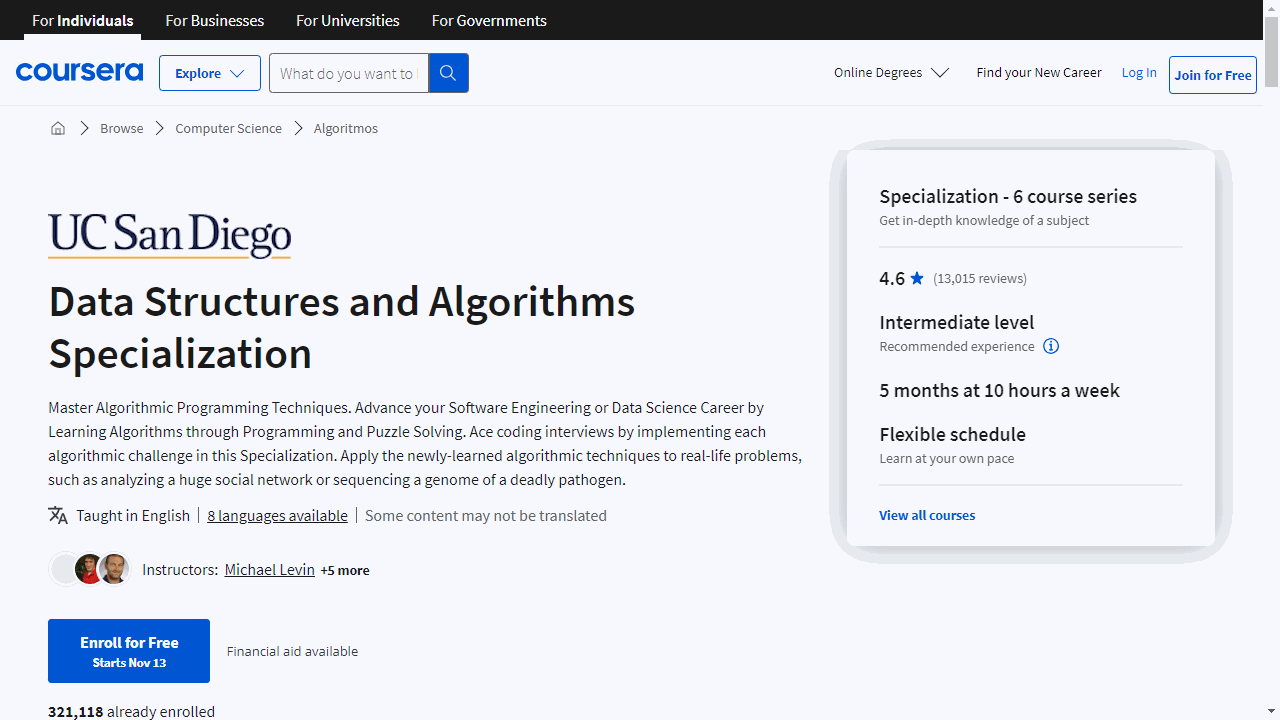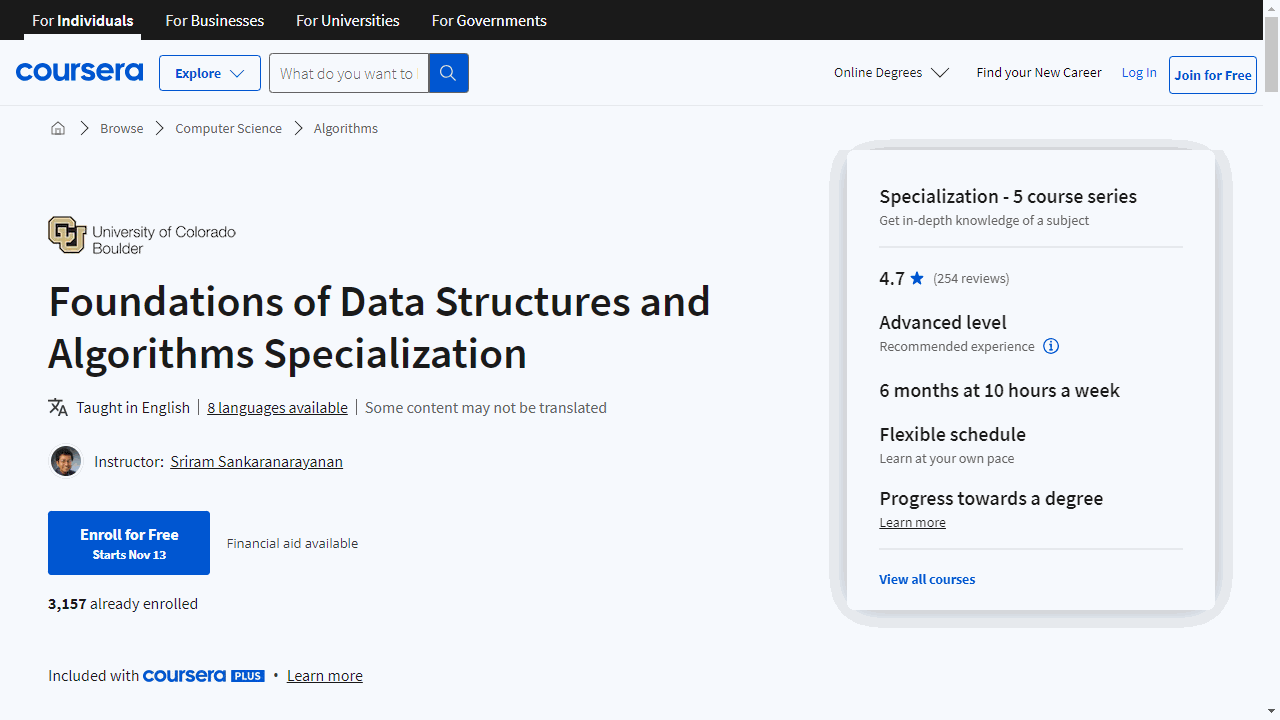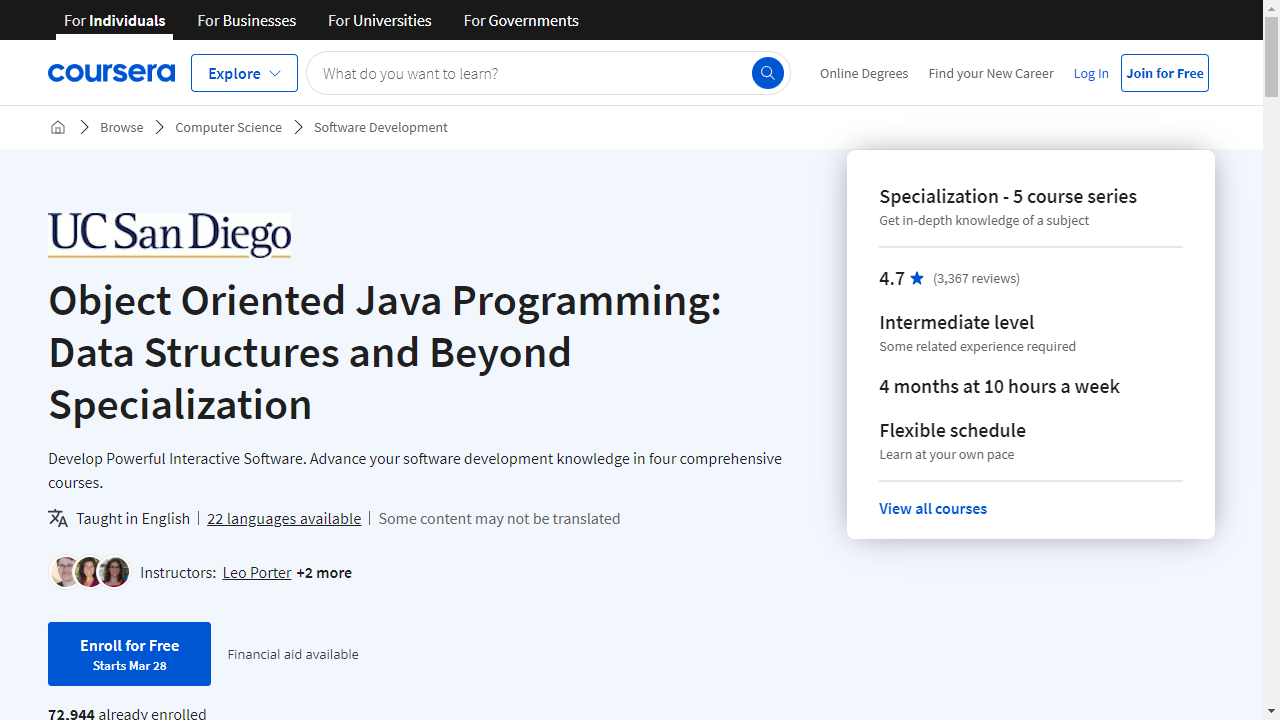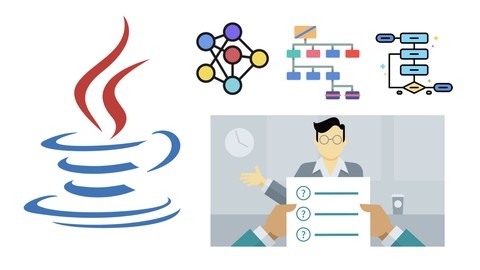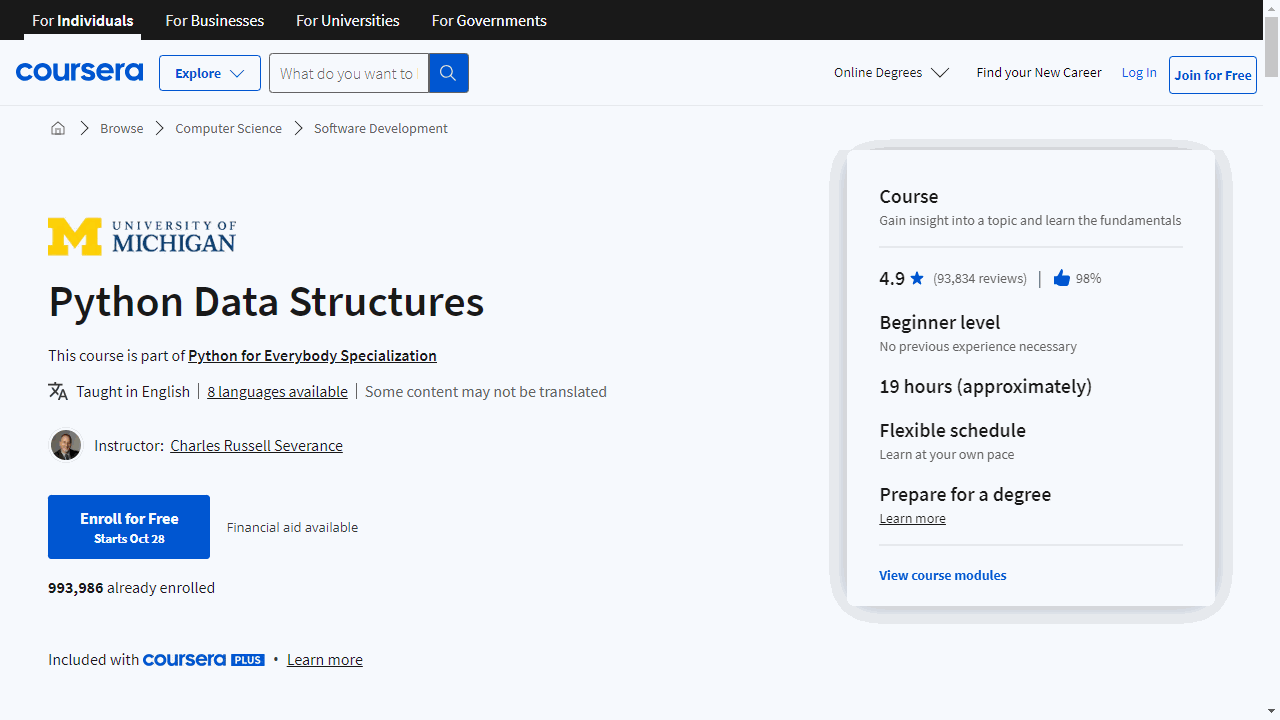Data structures and algorithms are the backbone of computer science, forming the foundation for efficient and optimized software.
They dictate how data is organized and processed, impacting the performance and scalability of applications.
By mastering these concepts, you can write code that runs faster, uses less memory, and tackles complex problems effectively.
This knowledge is crucial for any aspiring software developer or computer scientist, significantly enhancing your problem-solving abilities and opening doors to a wide range of exciting career opportunities.
Finding a comprehensive and well-structured course to learn data structures and algorithms can be a challenge, especially with the abundance of options available online.
You need a course that not only covers the theoretical concepts but also provides practical exercises and real-world applications to solidify your understanding.
It’s essential to choose a course that caters to your learning style and provides clear explanations, engaging examples, and ample opportunities to practice.
Based on our analysis, the Data Structures and Algorithms Specialization offered by Coursera stands out as the best overall choice.
This comprehensive specialization covers a wide range of topics, from fundamental algorithms like sorting and searching to advanced concepts like graph theory and dynamic programming.
It offers hands-on projects and coding challenges, allowing you to apply your knowledge and build practical skills.
The specialization is taught by experienced instructors and provides a structured learning path, making it suitable for learners of all levels.
While the Data Structures and Algorithms Specialization is our top recommendation, there are other excellent courses available that might better suit your specific needs or learning preferences.
We’ve compiled a list of the best data structures and algorithms courses available online, catering to different learning styles, programming languages, and levels of expertise.
Continue reading to explore these options and find the perfect course to embark on your data structures and algorithms learning journey.
Data Structures and Algorithms Specialization
Provider: Coursera
This Coursera specialization equips you with essential data structures and algorithms skills.
You will begin with the “Algorithmic Toolbox” course, learning fundamental techniques like sorting, searching, and dynamic programming, and practice solving coding challenges.
“Data Structures” delves into how these structures are implemented in languages like Python.
You will learn about dynamic arrays, priority queues, hash tables, and balanced binary trees.
“Algorithms on Graphs” introduces graph theory and algorithms used in navigation and network optimization.
You will discover how to find shortest paths and build minimum spanning trees, potentially applying this knowledge to the “Fast Shortest Routes” capstone project.
“Algorithms on Strings” explores techniques for efficiently searching and processing text, including tries, suffix trees, and the Burrows-Wheeler transform, essential for applications like search engines.
“Advanced Algorithms and Complexity” delves into network flows, crucial for optimization and scheduling, and linear programming, a powerful technique for solving optimization problems.
You will also explore computationally difficult problems and streaming algorithms used in handling massive datasets.
Finally, the “Genome Assembly Programming Challenge” allows you to apply your knowledge to assemble the genome of a deadly bacterial strain.
You will gain practical experience with bioinformatics and solidify your understanding of algorithms and data structures.
The Complete Data Structures and Algorithms Course in Python
Provider: Udemy
This course begins with a strong base in data structures and algorithms.
You will learn the differences between them, their importance in computer science, and the various types—such as arrays, lists, dictionaries, and heaps.
You will then explore Big O Notation, learning to calculate the time and space complexity of algorithms to understand how your code performs as data input grows.
You will then dive into practical applications, mastering arrays and lists.
You will learn about their creation, manipulation, and operations like insertion, traversal, and deletion.
The course also covers dictionaries, tuples, and object-oriented programming, providing the foundation for more complex data structures such as linked lists, stacks, and queues.
You will then tackle recursion, a powerful technique for breaking problems into smaller, similar parts.
You will understand its benefits, drawbacks, and common uses.
Building upon these core concepts, the course explores advanced data structures such as trees, graphs, heaps, and tries.
You will implement common operations like insertion, deletion, traversal, and search, preparing for technical interviews.
Finally, you will delve into essential algorithms for managing large datasets, including sorting algorithms like bubble sort, merge sort, and quicksort, and searching algorithms like linear search and binary search.
You’ll explore graph algorithms such as breadth-first search (BFS) and depth-first search (DFS), which are crucial for analyzing relationships within networks.
You will explore advanced algorithm design techniques like greedy algorithms, divide and conquer, and dynamic programming, equipping you to handle a wide range of complex problems efficiently.
You’ll also learn systematic problem-solving and backtracking techniques to navigate intricate scenarios.
Foundations of Data Structures and Algorithms Specialization
Provider: Coursera
This specialization equips you with the fundamentals of data structures and algorithms, essential knowledge for any aspiring programmer.
You begin with the basics of algorithm design and analysis, diving into sorting algorithms and working with data structures like priority queues and hash functions.
You will even learn about practical applications like Bloom filters, used to efficiently check for specific elements within large datasets.
The journey continues into the world of trees and graphs.
You master navigating tree data structures such as binary search trees and self-balancing trees.
You will then explore graphs, learning how to create and traverse them to represent relationships between entities.
The course even delves into specialized structures like kd-trees, used for organizing spatial data.
Prepare to explore powerful algorithm design techniques like divide and conquer, dynamic programming, and greedy algorithms – all crucial for tackling complex problems.
You will gain an understanding of intractability, which involves problems that are difficult to solve efficiently, and learn how linear and integer programming solvers can help address these challenges.
Finally, you will explore the captivating realm of approximation algorithms and linear programming.
You learn to formulate and solve optimization problems using these techniques, gaining insights into how they’re applied in resource allocation, scheduling, and task assignment.
You also uncover how approximation algorithms can provide effective solutions for problems that are otherwise difficult to solve precisely.
The specialization concludes by diving into advanced data structures, cryptography, and the fascinating world of quantum computing, including the renowned RSA cryptosystem, and how quantum algorithms have the potential to revolutionize the future of computing.
Python Data Structures & Algorithms + LEETCODE Exercises
Provider: Udemy
This Udemy course on data structures and algorithms will guide you through the fundamental building blocks of efficient code using Python.
You’ll begin with the basics of Big O notation, a crucial concept for understanding and analyzing the efficiency of algorithms.
You’ll learn how to determine the time and space complexity of your code, which is essential for writing scalable applications.
The course then delves into a variety of data structures, starting with linked lists.
You’ll learn how to create and manipulate these structures, performing actions like adding elements, removing elements, and searching.
From there, you’ll explore other fundamental structures like stacks, queues, trees (including binary search trees), hash tables, and graphs.
Each data structure is explained in detail, covering its properties, advantages, disadvantages, and common use cases in real-world applications.
Beyond just theoretical knowledge, this course emphasizes practical application and problem-solving.
You’ll work through a series of coding exercises designed to reinforce your understanding of each data structure.
The course also includes LeetCode exercises, allowing you to test your skills against real interview questions and prepare for technical interviews.
You’ll learn essential algorithmic techniques like recursion and dynamic programming, commonly encountered in coding challenges.
Plus, you’ll delve into various sorting algorithms, including bubble sort, selection sort, insertion sort, merge sort, and quicksort, understanding their implementations and trade-offs.
Object Oriented Java Programming: Data Structures and Beyond Specialization
Provider: Coursera
This specialization is perfect if you want to become a skilled software developer using Java.
You will learn how to use Java to build applications that can handle massive amounts of data, like Google Maps figuring out the fastest route.
You will begin with the fundamentals of Object-Oriented Programming in Java.
This will give you a strong base for the rest of the specialization.
Next, you will dive into essential data structures like linked lists, trees, and hashtables.
These are like different ways to organize information in your program.
You will use Big-O analysis to determine the most efficient way to store and retrieve data.
Think of it like finding the best way to arrange books on a shelf so you can quickly find the one you need!
You will then advance to complex data structures like graphs, which show the connections between things, and learn how to use them to solve real-world problems.
You will even build a route-planning application, similar to how Google Maps helps you navigate!
You will become comfortable working with these data structures through hands-on projects.
Finally, this specialization helps you get ready for software engineering interviews.
You will learn how to solve technical problems, communicate effectively during interviews, and get valuable tips from experienced Google engineers.
This will boost your confidence in landing your dream job.
To top it all off, you will get to apply your knowledge in a capstone project where you analyze real-world social network data.
You might explore how people are connected or identify influential communities.
Java Data Structures and Algorithms Masterclass
Provider: Udemy
This Java Data Structures and Algorithms Masterclass begins with the basics, ensuring you understand what data structures and algorithms are and why they are essential for any aspiring software developer.
You’ll explore different types of data structures such as arrays, linked lists, stacks, queues, and trees.
You’ll also learn about Big O notation, a way to analyze the efficiency of algorithms and see how well they perform as the input size grows.
The course then shifts gears to dive deeper into various data structures and their practical applications.
You will understand how to implement these structures in Java and learn when to use each one.
You will learn to solve real-world coding exercises from LeetCode, which top tech companies like those in FAANG often use during their interview process.
You will explore a wide array of algorithms, including sorting algorithms like bubble sort, merge sort, and quick sort, as well as searching algorithms like linear search and binary search.
You’ll also delve into graph algorithms like Depth First Search and Breadth First Search, equipping you with the skills to navigate and manipulate complex relationships within data.
The course introduces you to more advanced topics like dynamic programming, backtracking, and greedy algorithms, which will allow you to tackle intricate problems efficiently.
You’ll be challenged to apply your knowledge by tackling practical coding projects.
You’ll learn by doing, reinforcing your understanding of data structures and algorithms while building a portfolio demonstrating your abilities to potential employers.
You’ll be able to analyze problems, select the most appropriate data structures and algorithms, and write code that is both efficient and easy to understand.
Python Data Structures
Provider: Coursera
This Python Data Structures course guides you through the essentials using clear explanations and engaging examples.
You begin with the fundamentals of strings, learning how to manipulate them for various programming tasks.
You then delve into file processing, discovering how to read data from files and use it within your Python programs.
The course then introduces you to the concept of lists in Python.
You learn how to use lists to store and organize data, perform operations like adding or removing elements, and work with them alongside strings.
Building upon this, you explore dictionaries, a powerful way to store data using a key-value structure, much like a real-world dictionary.
You discover how to use dictionaries for tasks like counting occurrences of items and working with files.
You also explore tuples, which are similar to lists but immutable, meaning their values cannot be changed once defined.
This characteristic makes them suitable for specific programming scenarios.
The course doesn’t just stop at Python-specific concepts.
You also learn about JSON, a widely used data format for exchanging information between computers, and how it’s relevant in today’s interconnected world.
Throughout your journey, you benefit from worked exercises that reinforce your understanding and bonus content featuring insights from tech leaders who have shaped the landscape of programming languages like JavaScript and JQuery.
Java Data Structures & Algorithms + LEETCODE Exercises
Provider: Udemy
This Java Data Structures & Algorithms course teaches you how to write efficient code by understanding Big O notation.
You’ll explore fundamental data structures like linked lists, which are similar to chains of data.
You’ll discover how to add, remove, and navigate through them with ease.
The course then delves into more advanced structures like doubly linked lists, where you can move both forward and backward through the data, as well as stacks and queues, which are used in many real-world applications.
Next, you’ll explore trees, which are hierarchical data structures, and hash tables, known for their speed in searching and retrieving data.
You’ll master techniques like Breadth First Search (BFS) and Depth First Search (DFS) to traverse these trees effectively.
You’ll learn about heaps, a special type of tree perfect for finding the largest or smallest element quickly.
The course also covers recursion, a powerful technique where a function calls itself to break down complex problems into smaller, more manageable ones.
You’ll even tackle challenging interview questions like “Find the Middle Node in a Linked List” and “Reverse a String using a Stack.”
This hands-on practice will make you more confident in using these concepts in real-world scenarios.
You’ll explore common sorting algorithms like bubble sort, selection sort, and the more efficient merge sort and quick sort.
Finally, you’ll dive into dynamic programming, a technique for solving complex problems by breaking them down into smaller, overlapping subproblems.
Also check our posts on:
